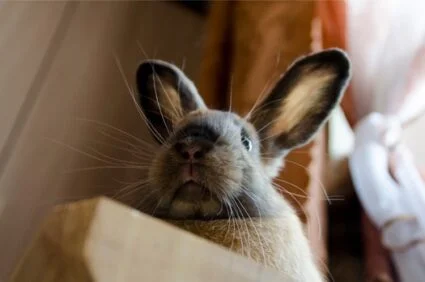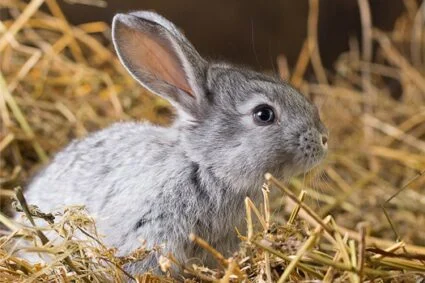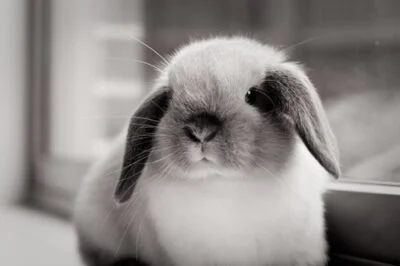Rabbits have whiskers on the mouth, cheeks, nose, and above the eyes. Their whiskers are the same length as the width of their bodies. Rabbit whiskers are vital sensory tools and should never be cut.
Whiskers help rabbits measure the girth of passageways and openings in the dark. The sensory nerves at the follicle end of each whisker are extremely sensitive, enabling clear orientation perception.
Rabbits’ eyes lack effective depth perception. Rabbits are also limited in their capacity to see objects up close. Whiskers aid in determining spatial relationships around rabbits, allowing them to gauge whether they’ll fit inside a burrow.
Why Do Rabbits Have Whiskers?
Rabbits have superior hearing, a large field of vision, and a keen sense of smell. They also have a remarkable sense of touch. They’re equipped with whiskers (vibrissae) on the nose, mouth, cheeks and the near the eyes that are thicker and stiffer than the hair on other parts of their body.
Whiskers are located in the nerve-rich regions of your rabbit’s body. Every whisker has a follicle at its end containing sensory nerves. This means that anything that touches your rabbit’s whiskers even lightly will be felt by your rabbit.
Measuring The Breadth Of Openings
The nerves in the vibrissal follicles are very sensitive and allow the rabbits to measure the breadth of tunnels, passageways, and holes before entering. If your rabbit is a healthy weight (not obese), its whiskers will be the same length as the widest part of its body.
If your rabbit cannot pass through a tunnel or opening comfortably, its whiskers will let it know.

Sensing Objects Nearby
Even though rabbits have a wide range of vision, they can’t focus as clearly as humans can. Therefore, they use their whiskers to sense objects close to their face.
In fact, a rabbit’s entire body is covered with sensitive nerve endings, which explains why they’re so responsive to touch. Rabbits love being petted, but it’s important never to approach them from the back as this is reminiscent of being approached by a predator.
Rabbits use their whiskers to navigate in poor lighting conditions. Their whiskers provide sensory input and feedback from objects close to your rabbit’s face. This can also be used in steering clear of hungry predators nearby and keeping away from dangerous objects.
Protection For The Eyes
The whiskers around your rabbit’s eyebrows also offer sensory feedback. Another critical function of eye whiskers is that they protect the eyes from fine particles and debris by catching them before they fall onto the eyes. This also warns your rabbit of obstacles near its head.
Without its whiskers, your rabbit will not be able to navigate around your home and sense the objects around it. Rabbit whiskers are a specialized form of sensitive touch feedback that rabbits heavily depend on.
Rabbit Vibrissae Anatomy
The vibrissa is a type of mammalian hair that differs from the ordinary (pelagic) hair in an animal’s body. It is categorized by its long length and innervated hair follicle. It also has a clear representation in the brain (somatosensory cortex), which is the region associated with the sense of touch.
The shaft is made up of an inert material, called keratin, which is a structural protein. The shaft does not contain any nerves, so it won’t hurt your rabbit if its whiskers get cut by mistake.
According to the Journal of Comparative Neurology, what makes whiskers different from other hair is that they grow from a special hair follicle that contains a blood capsule, called a blood sinus that is packed with sensory nerves.
The arrangement of whiskers on rabbits is not random. A large group of land and marine animals possesses mystacial macrovibrissae (mustache whiskers). According to the journal, Behavioral Brain Research, whiskers form an ordered grid of columns and rows, with longer whiskers in the back and shorter whiskers in the front.
Each whisker follicle in rabbits, mice, hamsters, rats, gerbils, guinea pigs, and cats is innervated with 100-200 primary afferent nerve cells (the ones that arrive at a brain region), according to the Journal of Comparative Neurology.
These nerve cells deliver to a larger number of receptors that respond to mechanical pressure and distortion. These receptors are called mechanoreceptors, and there are at least 8 distinct types involved in the process. Therefore, a study in the Journal of Neuroscience states that even the tiniest deflection of a whisker can stimulate a sensory response in an animal.
This indicates that whiskers are “proximal sensors” compared to vision, and enable tactile sense that is functionally imperative for a rabbit’s lifestyle.
How Do Whiskers Work in Rabbits?
Think of whiskers as an old-fashioned gramophone stylus. As the vibrissae brush onto an object, any irregularities on the surface of that object are translated into movements of the whiskers.
These movements are picked up by hundreds of motion sensors inside the vibrissal hair follicles.
The nerves then pass on specific information about the speed, direction, and duration of the movement of the whiskers. This allows the rabbit to determine the exact location, texture, size, and other essential details regarding the object concerned.
Can I Cut My Rabbit’s Whiskers?
You must never cut your rabbit’s whiskers because they are vital sensory tools. Rabbits aren’t able to focus as clearly as we can when there is an object right in front of them (a blind spot).
Rabbits need their whiskers to navigate through dark tunnels and measure the breadth of an opening or tunnel. If you do cut your rabbit’s whiskers, they will grow back in a few weeks.
My Rabbit’s Whiskers Are Too Long
If your rabbit’s whiskers are frayed and a bit curly on the ends, it’s okay to trim just a little bit to get rid of the damage. Whiskers that are long but in perfectly good shape do not need to be trimmed.
Trimming or cutting your rabbit’s whiskers will not cause your pet any pain. However, it isn’t recommended that you don’t cut your rabbit’s whiskers if:
- You’re simply cutting the whiskers because you’re trimming the fur on your bunny’s face
- You think they’re too long
- They’re not causing any inconvenience to your rabbit
A rabbit’s whiskers serve the vital function of aiding in navigation. Cutting them may affect your rabbit’s lifestyle. However, if you accidentally cut a couple, your rabbit won’t even notice. Just allow the whiskers to grow back on their own.

My Rabbit’s Whiskers Are Falling Out
Just like the rest of their fur, rabbits’ whiskers go through growth, dormancy and shedding phases. Therefore, if you find an odd whisker once in a while, it is normal and not a cause for concern.
However, if you notice your rabbit losing many whiskers within a short time period and its face does not appear as if it is replacing them, there may be something else going on.
Causes of Whisker Loss in Rabbits
Severe or complete whisker loss in rabbits isn’t common. However, there are many conditions that can lead to considerable shedding. Some of them include:
- Regular fighting with another rabbit. When rabbits fight, they often attack each other’s faces, genitals, or underside area. This can cause damage to a rabbit’s face and whisker breakage.
- Alopecia. Alopecia is a condition that affects many animals, including rabbits and humans. The condition can cause large scale loss of hair across the entire body, including the whiskers.
- Bacterial infections. These may lead to whisker loss if the infection affects the face or is systemic.
- Fungal infections. Fungal infections, such as ringworm, can affect a rabbit’s face, leading to vibrissae loss and round patches of hair loss.
- Dermatitis and other skin conditions. Conditions that are especially allergenic in nature can cause your rabbit’s whiskers to shed.
- Mite infestations. Loss of whiskers and fur may be accompanied by sore, irritated skin.
- Hormonal disorders, such as hypothyroidism. These may cause hair loss, whisker loss and changes in hair texture as it regrows.
If your rabbit is losing its whiskers and/or its fur, book an appointment with your vet. This will help you identify the cause so that treatment can be started.

